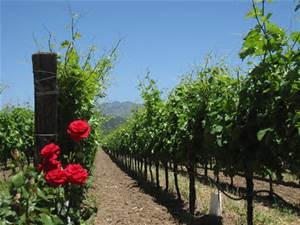
Vines throughout the valley are progressing through a process called veraison. Veraison is a French word signaling the start of the ripening process.Changes occur throughout the vine during this phase, but most importantly, veraison is when berries begin to ripen.
During veraison, berries become soft and take on the characteristic colors of the variety.Cabernet Sauvignon and Merlot grapes begin to change from green to red. From veraison until harvest, the berries will increase in size, weight and sugar content.The canes change from green to a woody brown,developing the strength needed to carry the weight of the grapes.
While veraison progresses, commercial and home growers take steps to protect the crop before harvest. Beginning with bud break in the spring, grape growers must constantly manage powdery mildew (Uncinulanecator) and botrytis (Botrytis cinerea).
In many vineyards, the spores that cause powdery mildew and botrytis are ubiquitous.A powdery mildew infection appears as a blue fungus on individual berries or bunches. Botrytis affects the internal tissues of the berry or the entire bunch. Berries split and fungal spores can proliferate. In both cases, home gardeners should remove and dispose of infected bunches to prevent wind from spreading the spores to healthy fruit. Spores of both diseases can also over-winter on vine bark and infect grapes the following year.
Grapes need leaves and sunshine to ripen. Monitoring the amount of leaves, their placement and their health is referred to as canopy management. Growers remove leaves at the base of the canes surrounding grape bunches to allow for light penetration and airflow. Then they continue to observe weather conditions and how the vineyards are oriented to the sun. They may do limited leaf removal on the west side during July and August. Over-exposing the crop can cause sunburn and bunch rot.
Home grape growers need to observe their microclimates and placement of buildings when determining how to manage the canopy. Irrigation is another way to manage canopy health. The goal is to keep the canopy healthy without promoting too much growth. During the final stages before harvest, growers mustmake irrigation decisions based on the size of the canopy, the weather, the age of the vineyard and the available soil moisture. Overstressed vines can lose leaves needed to complete ripening.
Pest management is always top of mind for growers. Vertebrate pests are a constant concern, but as ripening progresses, vineyard managers begin looking to the sky for other pests that enjoy ripe, sweet berries. Birds can devastate an entire crop. Growers use noisemakers and reflectors to deter them, but those methods may have limited or only short-term benefits. Netting may be used if bird pressure is high.
Bird netting is positioned on both sides of the vine row, protecting the fruit zone throughout the vineyard. It must be installed early, before hungry birds sense that the crop is sweet. If it is installed too tightly, birds can pierce the grapes while hanging onto the netting.
In the weeks preceding harvest, growers also mow or disk the vineyard floor to minimize weed seed production and to improve access by picking crews. This constant attention to detail protects our valley's most valuable crop and gets the winemaking off to a promising start.
Garden Tour: The Master Gardeners of Napa County invite you to attend their sixth garden tour, “Down the Garden Path,” on Sunday, September 13. On this self-guided educational tour, you will see seven gardens owned by Master Gardeners in and around the City of Napa. These gardens illustrate how Napa County Master Gardeners use University of California research-based horticultural information to develop and maintain their own gardens.Tickets: $30 advance / $35 day of event. Purchase tickets here: http://bit.ly/1fqLJZe. Or you can purchase tickets at the Master Gardener office (address below). For more information, call 707-253-4143.
Workshop: Napa County Master Gardeners will hold a workshop on “Home Vineyard: Part 2” on Saturday, August 15, from 9:30 a.m. to 2 p.m. (with a 30-minute lunch break. Learn what to do and what to look for and how to plan for harvest and crush in the vineyard, testing the must, managing the vines after crush, and preparing for winter and the next growing season. Master Gardeners with home vineyards will present this workshop, and answer your questions.Please bring a sack lunch, comfortable clothes and shoes for walking through the experimental vineyard. Location is the University of California Oakville Experimental Station, 1380 Oakville Grade Road, Napa. Online registration (credit card only)Mail-in registration (cash or check only)
Master Gardeners are volunteers who help the University of California reach the gardening public with home gardening information. Napa County Master Gardeners ( http://ucanr.org/ucmgnapa/) are available to answer gardening questions in person or by phone, Monday, Wednesday and Friday, 9 a.m. to Noon, at the U. C. Cooperative Extension office, 1710 Soscol Avenue, Suite 4, Napa, 707-253-4143, or from outside City of Napa toll-free at 877-279-3065. Or e-mail your garden questions by following the guidelines on our web site. Click on Napa, then on Have Garden Questions? Find us on Facebook under UC Master Gardeners of Napa County.